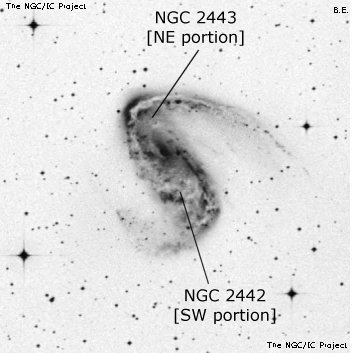NGC/IC Project Restoration Effort
(This is a very very beta version)
NGC2442


Basic Information
Location and Magnitude
Right Ascension: 7:36:23.8
Declination: -69:31:51
Constellation: VOL
Visual Magnitude: 10.4
Historic Information
Discoverer: Herschel J.
Year of discovery: 1834
Discovery aperture: 18.3
Observational
Summary description: cL, vF, R, D neb, 40°
Sub-type: SBbc
Corwin's Notes
=====
NGC 2442 and NGC 2443 are the southwest and northeast parts of a large, bright
galaxy observed four times by JH. The last three times, he described it as a
single large nebula, and measured a position for it that agrees very well with
the modern position. His first observation, however, makes it "A double
nebula, vF, vL, PA of centers = 40 deg, diameters 4' and 3' running together,
and having a star 13 mag at their junction." This is the interpretation that
he adopted for the GC, and that Dreyer used in the NGC. The "double star"
that JH noted during one observation is the nucleus and a superposed star (or
a compact HII region).
In the main table, I've given the position of the nucleus under both numbers,
and have also given positions for the approximate centers of the two parts of
the galaxy. Unfortunately, JH has only an RA for the preceding part that he
saw, but no NPD. For what it's worth, that RA is 13 seconds of time preceding
his position for the nucleus; this is close to the brightest part of the
southwestern arm of the galaxy.
Steve's Notes
=====
NGC 2442
24" (4/4/08 - Magellan Observatory, Australia): I was amazed how prominent the sweeping spiral arms appeared at 260x giving a stunning "S" appearance. The main bar of the galaxy is fairly bright and extended ~2:1 in a SW to NE orientation with a length of ~3'. The bar has just a weak, broad concentration with no real core but it rises sharply at the center to a very small, brighter nucleus. The main arm is attached at the northeast end of the bar and extends a short distance in that direction before dramatically bending sharply to the west (turning nearly 150ˇ) and extending ~3.5' in length towards a mag 12.9 star. At the NW end this well-defined arm fades and broadens a little, terminating just SE of the 13th magnitude star. At the SW end of the bar, a thick arm emerges extending to the SW where it more gently curves around towards the east while fanning out. This arm is not as sharply defined as the inside (east) portion of the curve blends with a diffuse glow extending from the bar. The total distance between the tips of the arms spans nearly 5'. In the same field 10' ENE lies ESO 59-11 and NGC 2534 is 16' NNW. The field also includes a number of mag 9 to 11 stars that frame the galaxy.
20" (7/8/02 - Magellan Observatory, Australia): at 127x (20mm Nagler), the main body of this unusual galaxy appeared as a fairly faint, large, thick "bar" with just a weak concentration except for an extremely small bright core. On the NE end of the bar, a faint "arm" emerged at a sharp angle towards the NW. The contrast was improved at 212x and the brighter arm was easier to view, extending at nearly a right angle to the main body and curving towards the west on the north side. On the SW end, a broad, short, low surface brightness extension was visible bending towards the SE. The main bar was elongated 2:1 SW-NE, roughly 3'x1.5', but the thick outer arm significantly increased the size to ~4.5'x2'.



